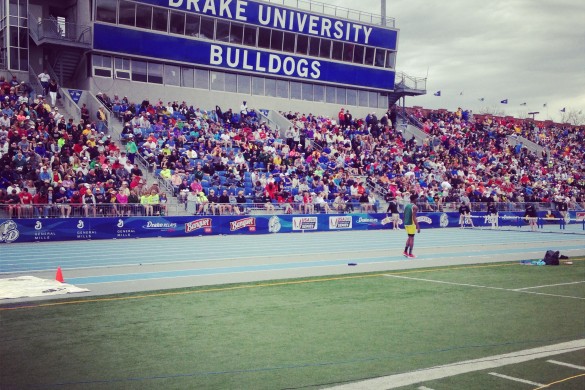Beets just out of the cooler await sorting into customer’s bins at Prudent Produce in Ankeny, Iowa. Each bin contains 10 to 15 items of produce every week. Photo by Sarah Fulton.
Words by Sarah Fulton and Avery Gregurich
It’s a Thursday morning in a nondescript industrial area south of Ankeny, Iowa. Inside Prudent Produce, the Laverty family is packing organic produce into plastic bins. It takes 54 seconds for the three of them to fill one with organic bananas and apples, local eggs and heads of romaine lettuce. Once packed, the reusable blue and green bins are loaded into several minivans. Finally, the three Lavertys, wife Angie, husband Darrin, and son Christian, take off on a GPS-determined path of delivery.
They represent modern-day milkmen, delivering grocery goods and produce to the doorsteps of homes around central Iowa. Their produce comes from organic co-ops and wholesalers year round, and from locally grown organic produce when available. The delivery process: updated by the Internet to ensure a more efficient route.
And lately the Lavertys have had to update their routes often. There has been a spike in demand for not just home-delivered groceries, but all goods. A 2015 Nielsen study found that one-quarter of respondents already order groceries online, and 55 percent are willing to do so in the future.

The Lavertys are trying to fill a need in their community. In the process, though, they may be benefiting the environment. A 2013 University of Washington study found that it can be more environmentally friendly to use delivery services like Prudent Produce. By comparing a set number of customers driving to the store versus being delivered to, researchers found that delivery actually creates less air pollution. Depending on population density and the relative location of customers, carbon dioxide emissions could be reduced anywhere between 20 to 90 percent.
One of the researchers, Anne Goodchild, an associate professor of civil and environmental engineering, says these findings may go against what consumers think is common sense.
“A lot of the times, people think that things that are environmentally sustainable are harder work,” Goodchild says. “Like, it is harder to ride your bike to work than get in your car and drive. It is harder to remember your grocery bags when you go to the grocery store. In general, people think the lazy option is not the most environmentally friendly, responsible one.”
In the case of grocery delivery, the lazy option can be greener. By striving to create efficient routes in order to keep costs low, delivery companies simultaneously reduce air pollutants. As Goodchild put it, what is good for business is also good for the environment.
“You get in your car — in your 3,000 pounds of metal — and drive it to the store to pick up 20 pounds of groceries and then drive the 3,000 pounds of metal back. Where as a grocery company really wants to be efficient and put as many grocery deliveries in that truck as possible. That is already their incentive,” Goodchild says.
Angie Laverty agrees: “You have to be sound about your choices or you end up losing money and you can’t help anybody.”
However, grocery delivery in its current state is not the end-all-be-all solution. In dense cities like Seattle, where the study was conducted, if everyone had their groceries delivered it could have the opposite effect. Trucks have to stop more frequently, meaning more pollutants are released. Delivery companies also tend not to operate in rural towns where their service would have the most impact.
“The good thing that we found is in those areas … is actually where we find the biggest benefit from delivery services because the trips to the grocery store can be so long,” Goodchild says.
Another major factor is consumer behavior. If a customer receives deliveries from Prudent Produce but still drives to the store every week to buy cereal, they are creating more air pollution. At the same time, if only one person from a neighborhood orders from a delivery service, the driver cannot plan an efficient route. Goodchild compares it to public bus systems: When only two people are on the bus it is not better for the air, but when everyone takes the bus the environmental impact is more significant.
Deciding to purchase organic in the first place also plays into the other end of grocery delivery. Cynthia James says it’s basic supply and demand. She’s the Agriculture Supported Communities program director at the Rodale Institute, a non-profit helping to lead the charge in organic farming research, and says by purchasing organic produce, consumers are contributing to a trend of conventional farmers moving to more sustainable methods.
“Ultimately when there is a market demand, farmers are going to change over,” James says. “So there is a consumer trend towards more organic, and we are also seeing a farmer trend towards more organic too.”
Studies at places like the Rodale Institute have shown organic produce is better for both soil and consumer health because it’s grown without artificial chemicals. Despite this, James says many farmers still employ traditional growing practices because early yields are so high, and for produce farmers organics can be labor intensive.
“It’s one of those things that if you think about it like a thoroughbred horse versus a draft horse: The thoroughbred horse is fast; it’s powerful. You know you are going to get great yields after the first year, but they don’t really have very long lives,” James says. “Whereas a draft horse is slow and steady and they get the job done. A lot of people just do not have the patience for it or they don’t see beyond a few years out. They are looking for the quick return.”
By purchasing organic produce, consumers help push farmers toward the draft horse. Local and state governments can also play a role by encouraging delivery services like Prudent Produce to expand their delivery areas. Angie Laverty says Prudent Produce currently is at full tilt. On average they deliver to between 60 and 85 residences a day, for a total of 350 deliveries a week. For their small operation, this is all they are capable of.
Goodchild says this is where the government can step in by offering tax breaks for percentages of delivery.
“We as communities put community resources into trying to reduce personal trips because we realize there is a benefit to everyone to do that,” Goodchild says. “We would argue that there may be places with certain constraints on those delivery services behaviors. It might not be the city of Seattle, but it might be the city of Des Moines that could give tax breaks for reaching a certain delivery volume.”
Until that point, Prudent Produce is doing all it can to be environmentally sound. They have a minimum delivery threshold before they will schedule a delivery route in a new area. They have zero food waste, donating the weekly excess to local food banks. Their reusable bins eliminate cardboard waste and additional food packaging. And, they support their local food communities through relationships with organic farmers, keeping both the food and the middleman local.
“If my apples are bruised, I want to talk to somebody in Ankeny,” Angie Laverty says. “I don’t want to talk to somebody in New Jersey. They know me. There’s a face.”














